Managing Change in Organizations: A Case Study of CEC Bank
VerifiedAdded on 2023/06/08
|15
|5296
|127
Report
AI Summary
This report examines the organizational change management strategies implemented by CEC Bank, a Romanian banking institution. It explores the nature of change processes, identifying both external and internal drivers, such as digital innovation and regulatory measures. The report utilizes the McKinsey 7S model to analyze the bank's strategy, structure, systems, staff, skills, shared values, and style, highlighting the impact of these elements on the change process. Key stakeholders are identified, and the report discusses strategies for managing resistance to change, including the application of Kurt Lewin's change model. Furthermore, it evaluates the management of knowledge, tracking, and migration during the change process, and compares and contrasts two change management models to diagnose and plan change within the organization. The report concludes by assessing the overall effectiveness of CEC Bank's transformation efforts, particularly in relation to its adoption of a low-code platform to enhance digital services and maintain a competitive edge in the Romanian banking market.
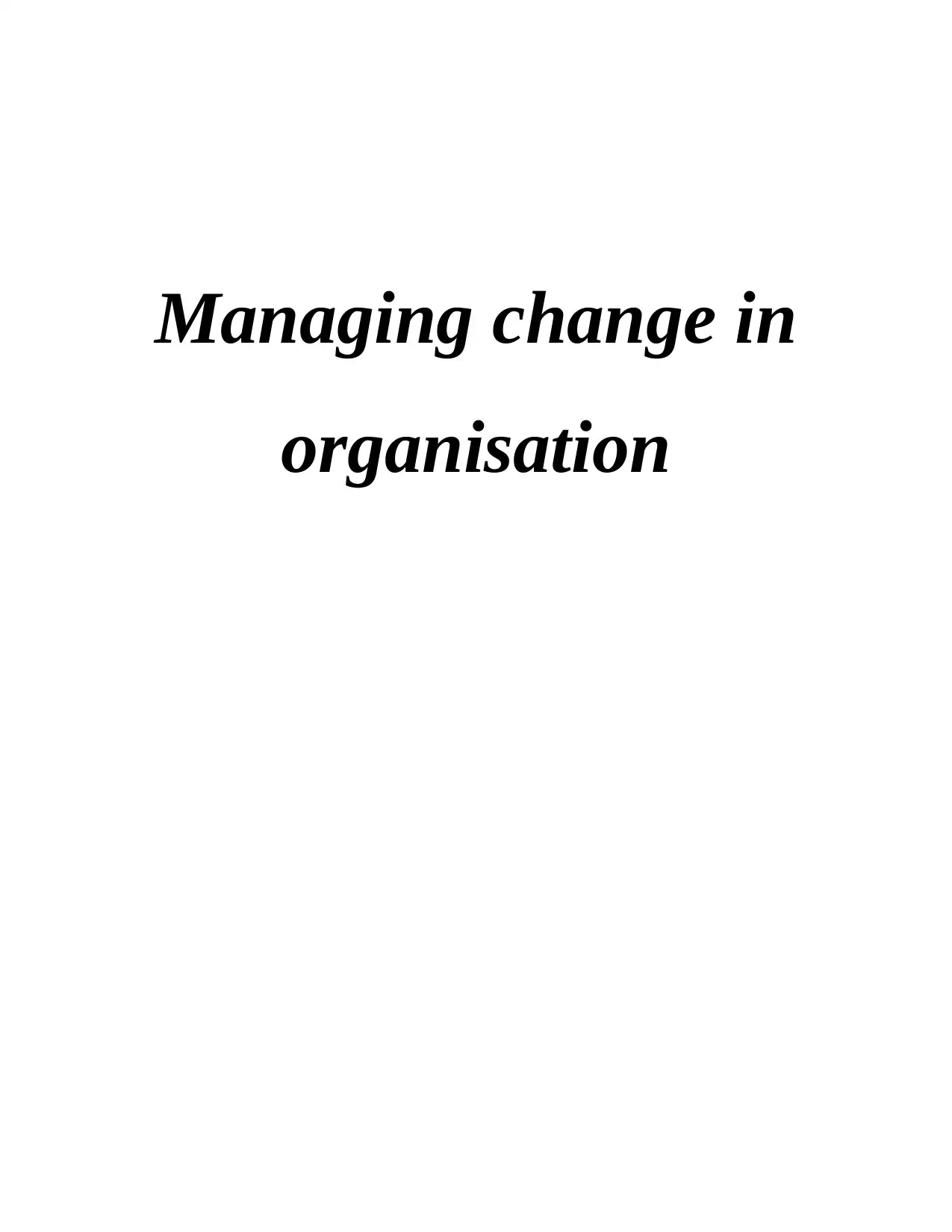
Managing change in
organisation
organisation
Paraphrase This Document
Need a fresh take? Get an instant paraphrase of this document with our AI Paraphraser
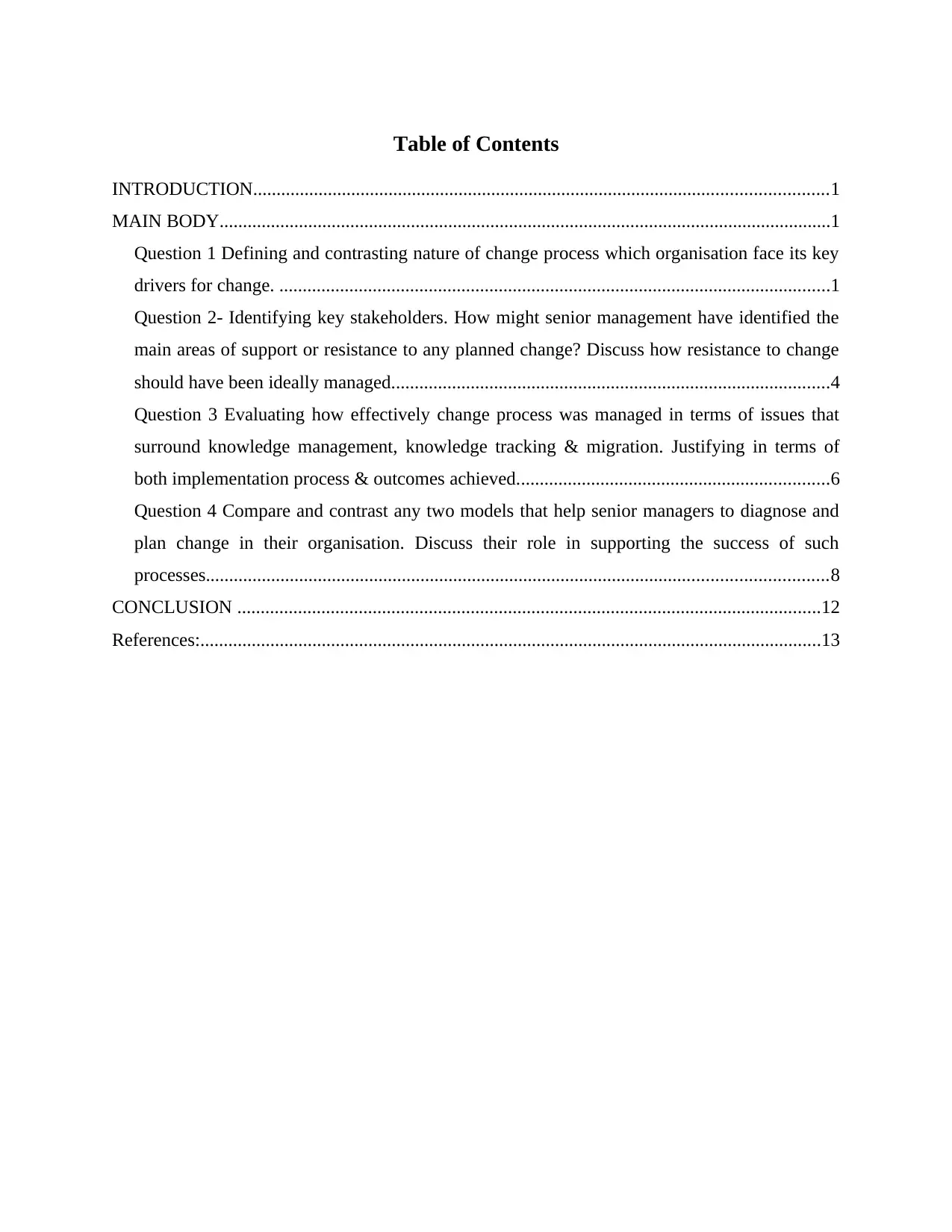
Table of Contents
INTRODUCTION...........................................................................................................................1
MAIN BODY...................................................................................................................................1
Question 1 Defining and contrasting nature of change process which organisation face its key
drivers for change. ......................................................................................................................1
Question 2- Identifying key stakeholders. How might senior management have identified the
main areas of support or resistance to any planned change? Discuss how resistance to change
should have been ideally managed..............................................................................................4
Question 3 Evaluating how effectively change process was managed in terms of issues that
surround knowledge management, knowledge tracking & migration. Justifying in terms of
both implementation process & outcomes achieved...................................................................6
Question 4 Compare and contrast any two models that help senior managers to diagnose and
plan change in their organisation. Discuss their role in supporting the success of such
processes.....................................................................................................................................8
CONCLUSION .............................................................................................................................12
References:.....................................................................................................................................13
INTRODUCTION...........................................................................................................................1
MAIN BODY...................................................................................................................................1
Question 1 Defining and contrasting nature of change process which organisation face its key
drivers for change. ......................................................................................................................1
Question 2- Identifying key stakeholders. How might senior management have identified the
main areas of support or resistance to any planned change? Discuss how resistance to change
should have been ideally managed..............................................................................................4
Question 3 Evaluating how effectively change process was managed in terms of issues that
surround knowledge management, knowledge tracking & migration. Justifying in terms of
both implementation process & outcomes achieved...................................................................6
Question 4 Compare and contrast any two models that help senior managers to diagnose and
plan change in their organisation. Discuss their role in supporting the success of such
processes.....................................................................................................................................8
CONCLUSION .............................................................................................................................12
References:.....................................................................................................................................13
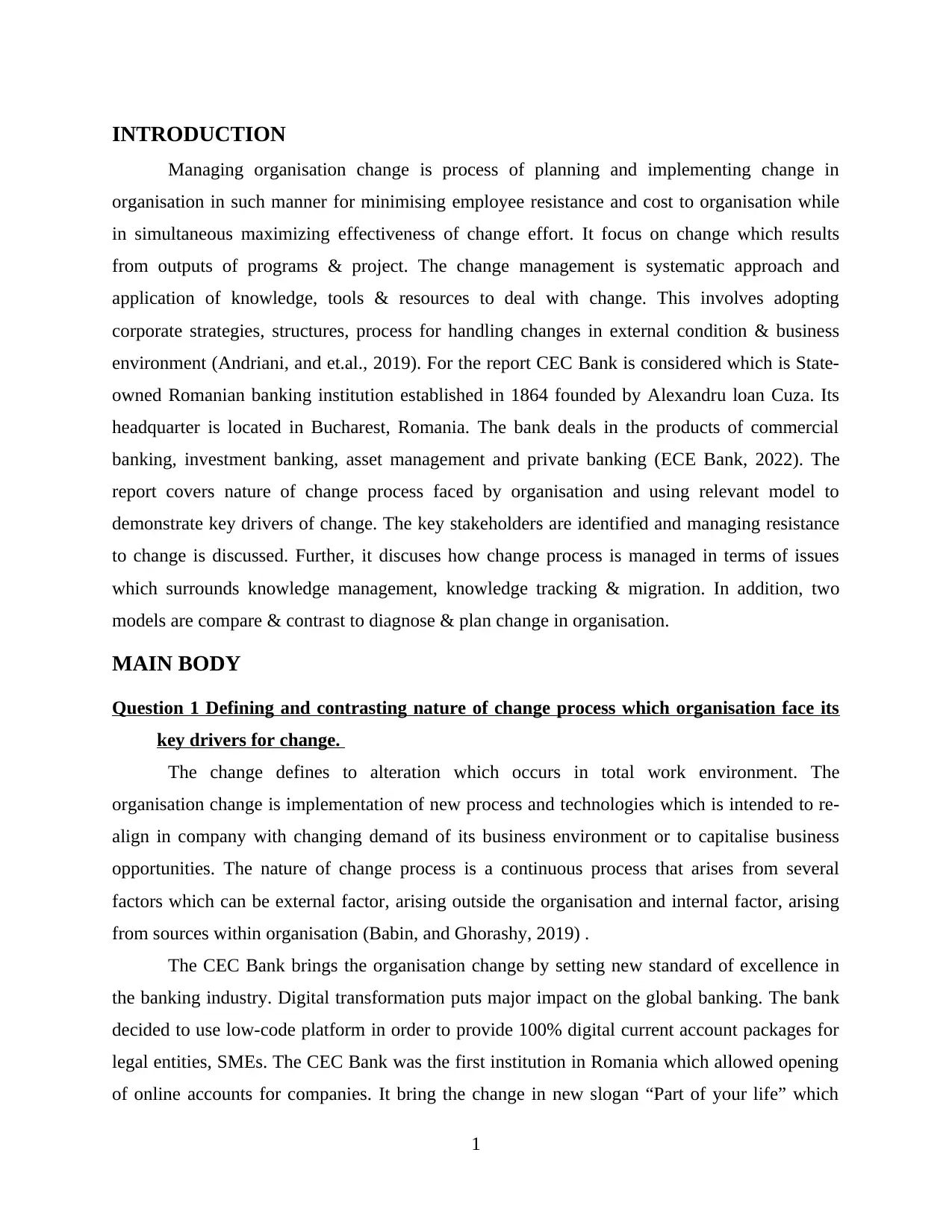
INTRODUCTION
Managing organisation change is process of planning and implementing change in
organisation in such manner for minimising employee resistance and cost to organisation while
in simultaneous maximizing effectiveness of change effort. It focus on change which results
from outputs of programs & project. The change management is systematic approach and
application of knowledge, tools & resources to deal with change. This involves adopting
corporate strategies, structures, process for handling changes in external condition & business
environment (Andriani, and et.al., 2019). For the report CEC Bank is considered which is State-
owned Romanian banking institution established in 1864 founded by Alexandru loan Cuza. Its
headquarter is located in Bucharest, Romania. The bank deals in the products of commercial
banking, investment banking, asset management and private banking (ECE Bank, 2022). The
report covers nature of change process faced by organisation and using relevant model to
demonstrate key drivers of change. The key stakeholders are identified and managing resistance
to change is discussed. Further, it discuses how change process is managed in terms of issues
which surrounds knowledge management, knowledge tracking & migration. In addition, two
models are compare & contrast to diagnose & plan change in organisation.
MAIN BODY
Question 1 Defining and contrasting nature of change process which organisation face its
key drivers for change.
The change defines to alteration which occurs in total work environment. The
organisation change is implementation of new process and technologies which is intended to re-
align in company with changing demand of its business environment or to capitalise business
opportunities. The nature of change process is a continuous process that arises from several
factors which can be external factor, arising outside the organisation and internal factor, arising
from sources within organisation (Babin, and Ghorashy, 2019) .
The CEC Bank brings the organisation change by setting new standard of excellence in
the banking industry. Digital transformation puts major impact on the global banking. The bank
decided to use low-code platform in order to provide 100% digital current account packages for
legal entities, SMEs. The CEC Bank was the first institution in Romania which allowed opening
of online accounts for companies. It bring the change in new slogan “Part of your life” which
1
Managing organisation change is process of planning and implementing change in
organisation in such manner for minimising employee resistance and cost to organisation while
in simultaneous maximizing effectiveness of change effort. It focus on change which results
from outputs of programs & project. The change management is systematic approach and
application of knowledge, tools & resources to deal with change. This involves adopting
corporate strategies, structures, process for handling changes in external condition & business
environment (Andriani, and et.al., 2019). For the report CEC Bank is considered which is State-
owned Romanian banking institution established in 1864 founded by Alexandru loan Cuza. Its
headquarter is located in Bucharest, Romania. The bank deals in the products of commercial
banking, investment banking, asset management and private banking (ECE Bank, 2022). The
report covers nature of change process faced by organisation and using relevant model to
demonstrate key drivers of change. The key stakeholders are identified and managing resistance
to change is discussed. Further, it discuses how change process is managed in terms of issues
which surrounds knowledge management, knowledge tracking & migration. In addition, two
models are compare & contrast to diagnose & plan change in organisation.
MAIN BODY
Question 1 Defining and contrasting nature of change process which organisation face its
key drivers for change.
The change defines to alteration which occurs in total work environment. The
organisation change is implementation of new process and technologies which is intended to re-
align in company with changing demand of its business environment or to capitalise business
opportunities. The nature of change process is a continuous process that arises from several
factors which can be external factor, arising outside the organisation and internal factor, arising
from sources within organisation (Babin, and Ghorashy, 2019) .
The CEC Bank brings the organisation change by setting new standard of excellence in
the banking industry. Digital transformation puts major impact on the global banking. The bank
decided to use low-code platform in order to provide 100% digital current account packages for
legal entities, SMEs. The CEC Bank was the first institution in Romania which allowed opening
of online accounts for companies. It bring the change in new slogan “Part of your life” which
1
⊘ This is a preview!⊘
Do you want full access?
Subscribe today to unlock all pages.

Trusted by 1+ million students worldwide
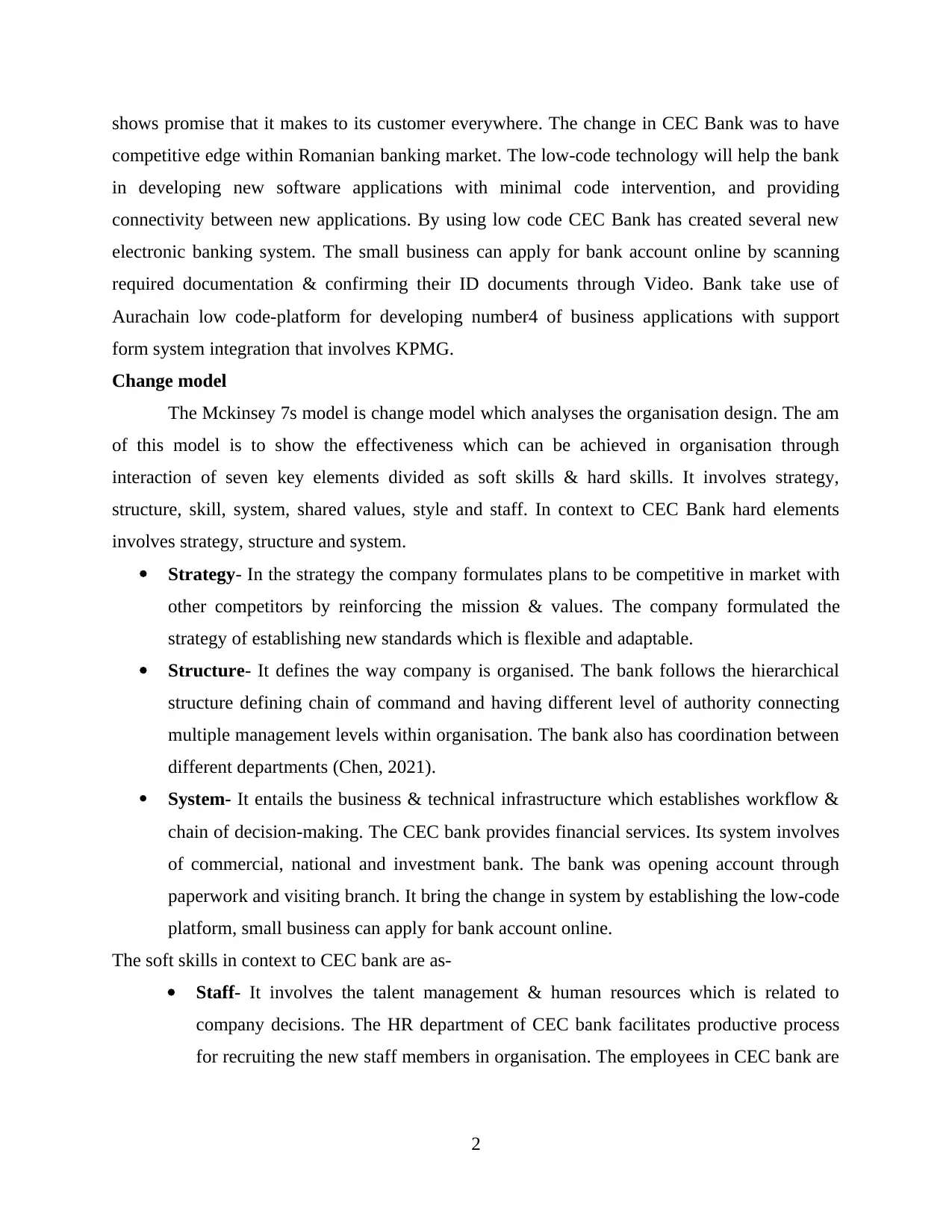
shows promise that it makes to its customer everywhere. The change in CEC Bank was to have
competitive edge within Romanian banking market. The low-code technology will help the bank
in developing new software applications with minimal code intervention, and providing
connectivity between new applications. By using low code CEC Bank has created several new
electronic banking system. The small business can apply for bank account online by scanning
required documentation & confirming their ID documents through Video. Bank take use of
Aurachain low code-platform for developing number4 of business applications with support
form system integration that involves KPMG.
Change model
The Mckinsey 7s model is change model which analyses the organisation design. The am
of this model is to show the effectiveness which can be achieved in organisation through
interaction of seven key elements divided as soft skills & hard skills. It involves strategy,
structure, skill, system, shared values, style and staff. In context to CEC Bank hard elements
involves strategy, structure and system.
Strategy- In the strategy the company formulates plans to be competitive in market with
other competitors by reinforcing the mission & values. The company formulated the
strategy of establishing new standards which is flexible and adaptable.
Structure- It defines the way company is organised. The bank follows the hierarchical
structure defining chain of command and having different level of authority connecting
multiple management levels within organisation. The bank also has coordination between
different departments (Chen, 2021).
System- It entails the business & technical infrastructure which establishes workflow &
chain of decision-making. The CEC bank provides financial services. Its system involves
of commercial, national and investment bank. The bank was opening account through
paperwork and visiting branch. It bring the change in system by establishing the low-code
platform, small business can apply for bank account online.
The soft skills in context to CEC bank are as-
Staff- It involves the talent management & human resources which is related to
company decisions. The HR department of CEC bank facilitates productive process
for recruiting the new staff members in organisation. The employees in CEC bank are
2
competitive edge within Romanian banking market. The low-code technology will help the bank
in developing new software applications with minimal code intervention, and providing
connectivity between new applications. By using low code CEC Bank has created several new
electronic banking system. The small business can apply for bank account online by scanning
required documentation & confirming their ID documents through Video. Bank take use of
Aurachain low code-platform for developing number4 of business applications with support
form system integration that involves KPMG.
Change model
The Mckinsey 7s model is change model which analyses the organisation design. The am
of this model is to show the effectiveness which can be achieved in organisation through
interaction of seven key elements divided as soft skills & hard skills. It involves strategy,
structure, skill, system, shared values, style and staff. In context to CEC Bank hard elements
involves strategy, structure and system.
Strategy- In the strategy the company formulates plans to be competitive in market with
other competitors by reinforcing the mission & values. The company formulated the
strategy of establishing new standards which is flexible and adaptable.
Structure- It defines the way company is organised. The bank follows the hierarchical
structure defining chain of command and having different level of authority connecting
multiple management levels within organisation. The bank also has coordination between
different departments (Chen, 2021).
System- It entails the business & technical infrastructure which establishes workflow &
chain of decision-making. The CEC bank provides financial services. Its system involves
of commercial, national and investment bank. The bank was opening account through
paperwork and visiting branch. It bring the change in system by establishing the low-code
platform, small business can apply for bank account online.
The soft skills in context to CEC bank are as-
Staff- It involves the talent management & human resources which is related to
company decisions. The HR department of CEC bank facilitates productive process
for recruiting the new staff members in organisation. The employees in CEC bank are
2
Paraphrase This Document
Need a fresh take? Get an instant paraphrase of this document with our AI Paraphraser
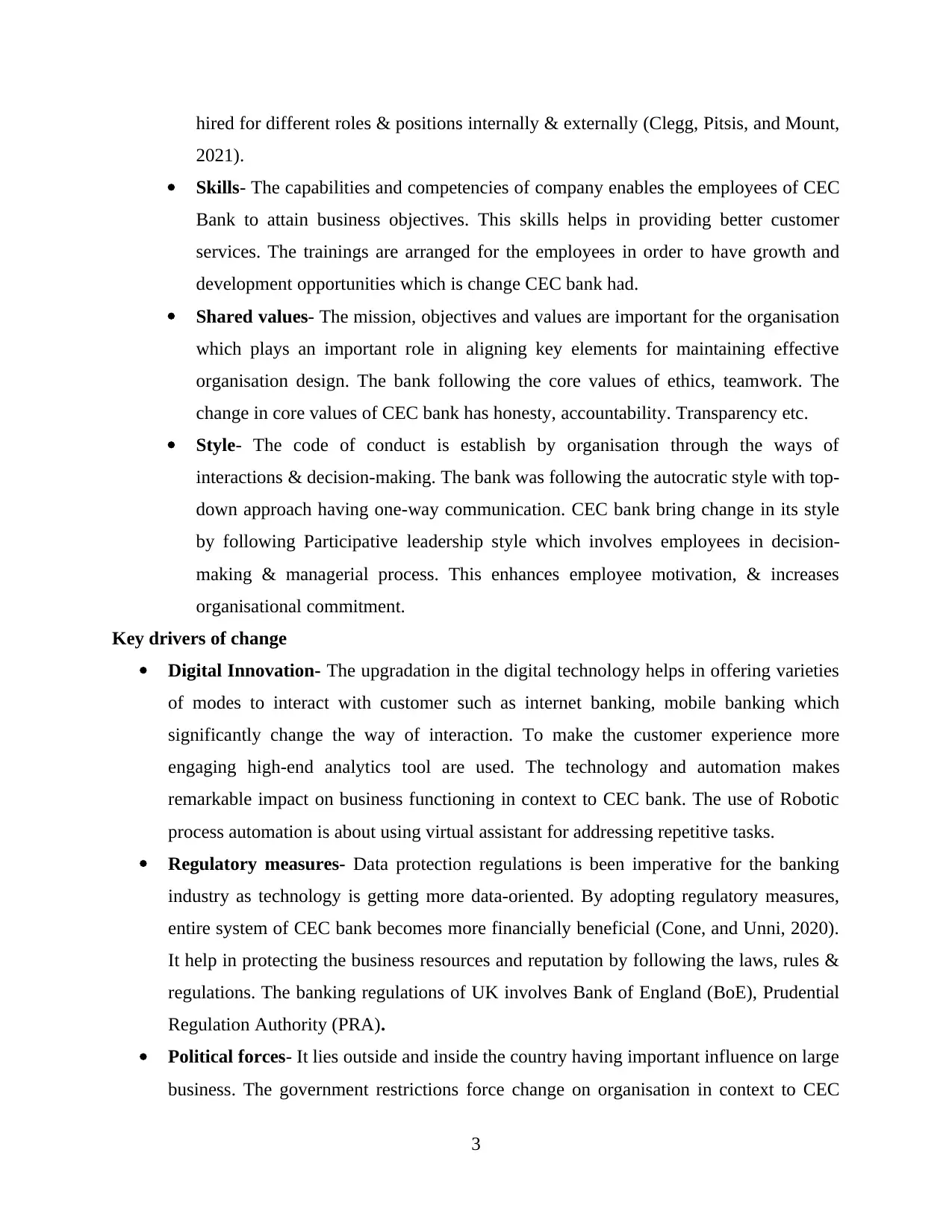
hired for different roles & positions internally & externally (Clegg, Pitsis, and Mount,
2021).
Skills- The capabilities and competencies of company enables the employees of CEC
Bank to attain business objectives. This skills helps in providing better customer
services. The trainings are arranged for the employees in order to have growth and
development opportunities which is change CEC bank had.
Shared values- The mission, objectives and values are important for the organisation
which plays an important role in aligning key elements for maintaining effective
organisation design. The bank following the core values of ethics, teamwork. The
change in core values of CEC bank has honesty, accountability. Transparency etc.
Style- The code of conduct is establish by organisation through the ways of
interactions & decision-making. The bank was following the autocratic style with top-
down approach having one-way communication. CEC bank bring change in its style
by following Participative leadership style which involves employees in decision-
making & managerial process. This enhances employee motivation, & increases
organisational commitment.
Key drivers of change
Digital Innovation- The upgradation in the digital technology helps in offering varieties
of modes to interact with customer such as internet banking, mobile banking which
significantly change the way of interaction. To make the customer experience more
engaging high-end analytics tool are used. The technology and automation makes
remarkable impact on business functioning in context to CEC bank. The use of Robotic
process automation is about using virtual assistant for addressing repetitive tasks.
Regulatory measures- Data protection regulations is been imperative for the banking
industry as technology is getting more data-oriented. By adopting regulatory measures,
entire system of CEC bank becomes more financially beneficial (Cone, and Unni, 2020).
It help in protecting the business resources and reputation by following the laws, rules &
regulations. The banking regulations of UK involves Bank of England (BoE), Prudential
Regulation Authority (PRA).
Political forces- It lies outside and inside the country having important influence on large
business. The government restrictions force change on organisation in context to CEC
3
2021).
Skills- The capabilities and competencies of company enables the employees of CEC
Bank to attain business objectives. This skills helps in providing better customer
services. The trainings are arranged for the employees in order to have growth and
development opportunities which is change CEC bank had.
Shared values- The mission, objectives and values are important for the organisation
which plays an important role in aligning key elements for maintaining effective
organisation design. The bank following the core values of ethics, teamwork. The
change in core values of CEC bank has honesty, accountability. Transparency etc.
Style- The code of conduct is establish by organisation through the ways of
interactions & decision-making. The bank was following the autocratic style with top-
down approach having one-way communication. CEC bank bring change in its style
by following Participative leadership style which involves employees in decision-
making & managerial process. This enhances employee motivation, & increases
organisational commitment.
Key drivers of change
Digital Innovation- The upgradation in the digital technology helps in offering varieties
of modes to interact with customer such as internet banking, mobile banking which
significantly change the way of interaction. To make the customer experience more
engaging high-end analytics tool are used. The technology and automation makes
remarkable impact on business functioning in context to CEC bank. The use of Robotic
process automation is about using virtual assistant for addressing repetitive tasks.
Regulatory measures- Data protection regulations is been imperative for the banking
industry as technology is getting more data-oriented. By adopting regulatory measures,
entire system of CEC bank becomes more financially beneficial (Cone, and Unni, 2020).
It help in protecting the business resources and reputation by following the laws, rules &
regulations. The banking regulations of UK involves Bank of England (BoE), Prudential
Regulation Authority (PRA).
Political forces- It lies outside and inside the country having important influence on large
business. The government restrictions force change on organisation in context to CEC
3
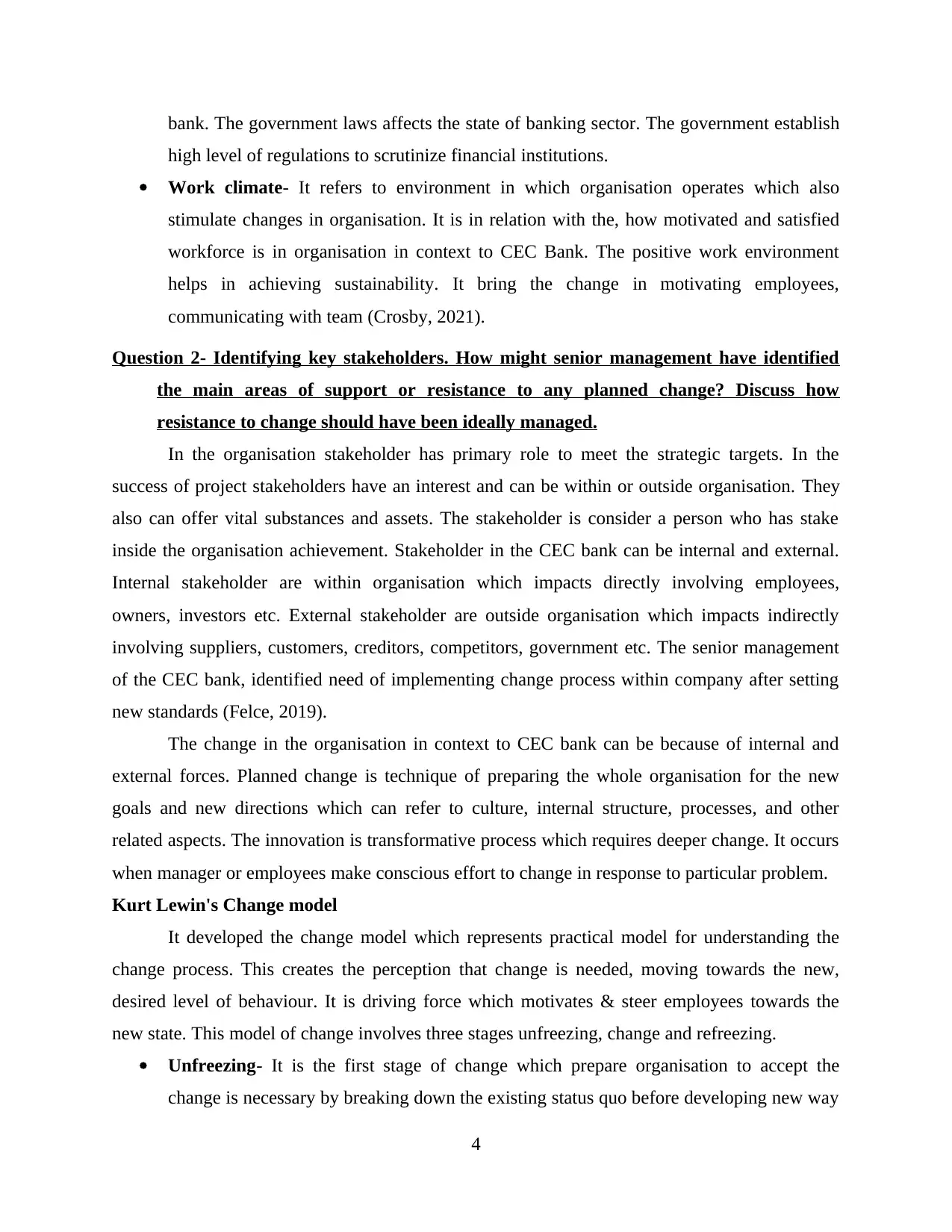
bank. The government laws affects the state of banking sector. The government establish
high level of regulations to scrutinize financial institutions.
Work climate- It refers to environment in which organisation operates which also
stimulate changes in organisation. It is in relation with the, how motivated and satisfied
workforce is in organisation in context to CEC Bank. The positive work environment
helps in achieving sustainability. It bring the change in motivating employees,
communicating with team (Crosby, 2021).
Question 2- Identifying key stakeholders. How might senior management have identified
the main areas of support or resistance to any planned change? Discuss how
resistance to change should have been ideally managed.
In the organisation stakeholder has primary role to meet the strategic targets. In the
success of project stakeholders have an interest and can be within or outside organisation. They
also can offer vital substances and assets. The stakeholder is consider a person who has stake
inside the organisation achievement. Stakeholder in the CEC bank can be internal and external.
Internal stakeholder are within organisation which impacts directly involving employees,
owners, investors etc. External stakeholder are outside organisation which impacts indirectly
involving suppliers, customers, creditors, competitors, government etc. The senior management
of the CEC bank, identified need of implementing change process within company after setting
new standards (Felce, 2019).
The change in the organisation in context to CEC bank can be because of internal and
external forces. Planned change is technique of preparing the whole organisation for the new
goals and new directions which can refer to culture, internal structure, processes, and other
related aspects. The innovation is transformative process which requires deeper change. It occurs
when manager or employees make conscious effort to change in response to particular problem.
Kurt Lewin's Change model
It developed the change model which represents practical model for understanding the
change process. This creates the perception that change is needed, moving towards the new,
desired level of behaviour. It is driving force which motivates & steer employees towards the
new state. This model of change involves three stages unfreezing, change and refreezing.
Unfreezing- It is the first stage of change which prepare organisation to accept the
change is necessary by breaking down the existing status quo before developing new way
4
high level of regulations to scrutinize financial institutions.
Work climate- It refers to environment in which organisation operates which also
stimulate changes in organisation. It is in relation with the, how motivated and satisfied
workforce is in organisation in context to CEC Bank. The positive work environment
helps in achieving sustainability. It bring the change in motivating employees,
communicating with team (Crosby, 2021).
Question 2- Identifying key stakeholders. How might senior management have identified
the main areas of support or resistance to any planned change? Discuss how
resistance to change should have been ideally managed.
In the organisation stakeholder has primary role to meet the strategic targets. In the
success of project stakeholders have an interest and can be within or outside organisation. They
also can offer vital substances and assets. The stakeholder is consider a person who has stake
inside the organisation achievement. Stakeholder in the CEC bank can be internal and external.
Internal stakeholder are within organisation which impacts directly involving employees,
owners, investors etc. External stakeholder are outside organisation which impacts indirectly
involving suppliers, customers, creditors, competitors, government etc. The senior management
of the CEC bank, identified need of implementing change process within company after setting
new standards (Felce, 2019).
The change in the organisation in context to CEC bank can be because of internal and
external forces. Planned change is technique of preparing the whole organisation for the new
goals and new directions which can refer to culture, internal structure, processes, and other
related aspects. The innovation is transformative process which requires deeper change. It occurs
when manager or employees make conscious effort to change in response to particular problem.
Kurt Lewin's Change model
It developed the change model which represents practical model for understanding the
change process. This creates the perception that change is needed, moving towards the new,
desired level of behaviour. It is driving force which motivates & steer employees towards the
new state. This model of change involves three stages unfreezing, change and refreezing.
Unfreezing- It is the first stage of change which prepare organisation to accept the
change is necessary by breaking down the existing status quo before developing new way
4
⊘ This is a preview!⊘
Do you want full access?
Subscribe today to unlock all pages.

Trusted by 1+ million students worldwide
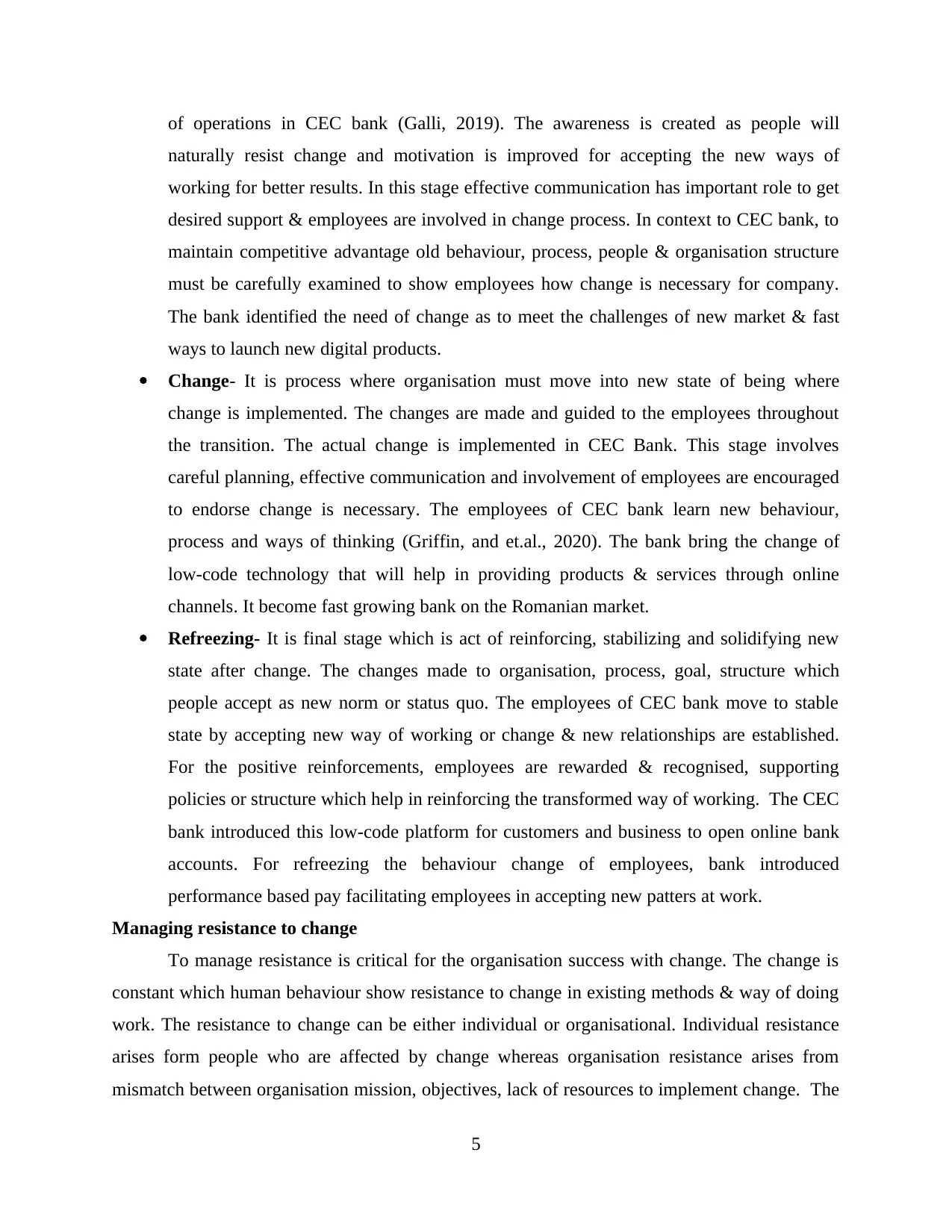
of operations in CEC bank (Galli, 2019). The awareness is created as people will
naturally resist change and motivation is improved for accepting the new ways of
working for better results. In this stage effective communication has important role to get
desired support & employees are involved in change process. In context to CEC bank, to
maintain competitive advantage old behaviour, process, people & organisation structure
must be carefully examined to show employees how change is necessary for company.
The bank identified the need of change as to meet the challenges of new market & fast
ways to launch new digital products.
Change- It is process where organisation must move into new state of being where
change is implemented. The changes are made and guided to the employees throughout
the transition. The actual change is implemented in CEC Bank. This stage involves
careful planning, effective communication and involvement of employees are encouraged
to endorse change is necessary. The employees of CEC bank learn new behaviour,
process and ways of thinking (Griffin, and et.al., 2020). The bank bring the change of
low-code technology that will help in providing products & services through online
channels. It become fast growing bank on the Romanian market.
Refreezing- It is final stage which is act of reinforcing, stabilizing and solidifying new
state after change. The changes made to organisation, process, goal, structure which
people accept as new norm or status quo. The employees of CEC bank move to stable
state by accepting new way of working or change & new relationships are established.
For the positive reinforcements, employees are rewarded & recognised, supporting
policies or structure which help in reinforcing the transformed way of working. The CEC
bank introduced this low-code platform for customers and business to open online bank
accounts. For refreezing the behaviour change of employees, bank introduced
performance based pay facilitating employees in accepting new patters at work.
Managing resistance to change
To manage resistance is critical for the organisation success with change. The change is
constant which human behaviour show resistance to change in existing methods & way of doing
work. The resistance to change can be either individual or organisational. Individual resistance
arises form people who are affected by change whereas organisation resistance arises from
mismatch between organisation mission, objectives, lack of resources to implement change. The
5
naturally resist change and motivation is improved for accepting the new ways of
working for better results. In this stage effective communication has important role to get
desired support & employees are involved in change process. In context to CEC bank, to
maintain competitive advantage old behaviour, process, people & organisation structure
must be carefully examined to show employees how change is necessary for company.
The bank identified the need of change as to meet the challenges of new market & fast
ways to launch new digital products.
Change- It is process where organisation must move into new state of being where
change is implemented. The changes are made and guided to the employees throughout
the transition. The actual change is implemented in CEC Bank. This stage involves
careful planning, effective communication and involvement of employees are encouraged
to endorse change is necessary. The employees of CEC bank learn new behaviour,
process and ways of thinking (Griffin, and et.al., 2020). The bank bring the change of
low-code technology that will help in providing products & services through online
channels. It become fast growing bank on the Romanian market.
Refreezing- It is final stage which is act of reinforcing, stabilizing and solidifying new
state after change. The changes made to organisation, process, goal, structure which
people accept as new norm or status quo. The employees of CEC bank move to stable
state by accepting new way of working or change & new relationships are established.
For the positive reinforcements, employees are rewarded & recognised, supporting
policies or structure which help in reinforcing the transformed way of working. The CEC
bank introduced this low-code platform for customers and business to open online bank
accounts. For refreezing the behaviour change of employees, bank introduced
performance based pay facilitating employees in accepting new patters at work.
Managing resistance to change
To manage resistance is critical for the organisation success with change. The change is
constant which human behaviour show resistance to change in existing methods & way of doing
work. The resistance to change can be either individual or organisational. Individual resistance
arises form people who are affected by change whereas organisation resistance arises from
mismatch between organisation mission, objectives, lack of resources to implement change. The
5
Paraphrase This Document
Need a fresh take? Get an instant paraphrase of this document with our AI Paraphraser
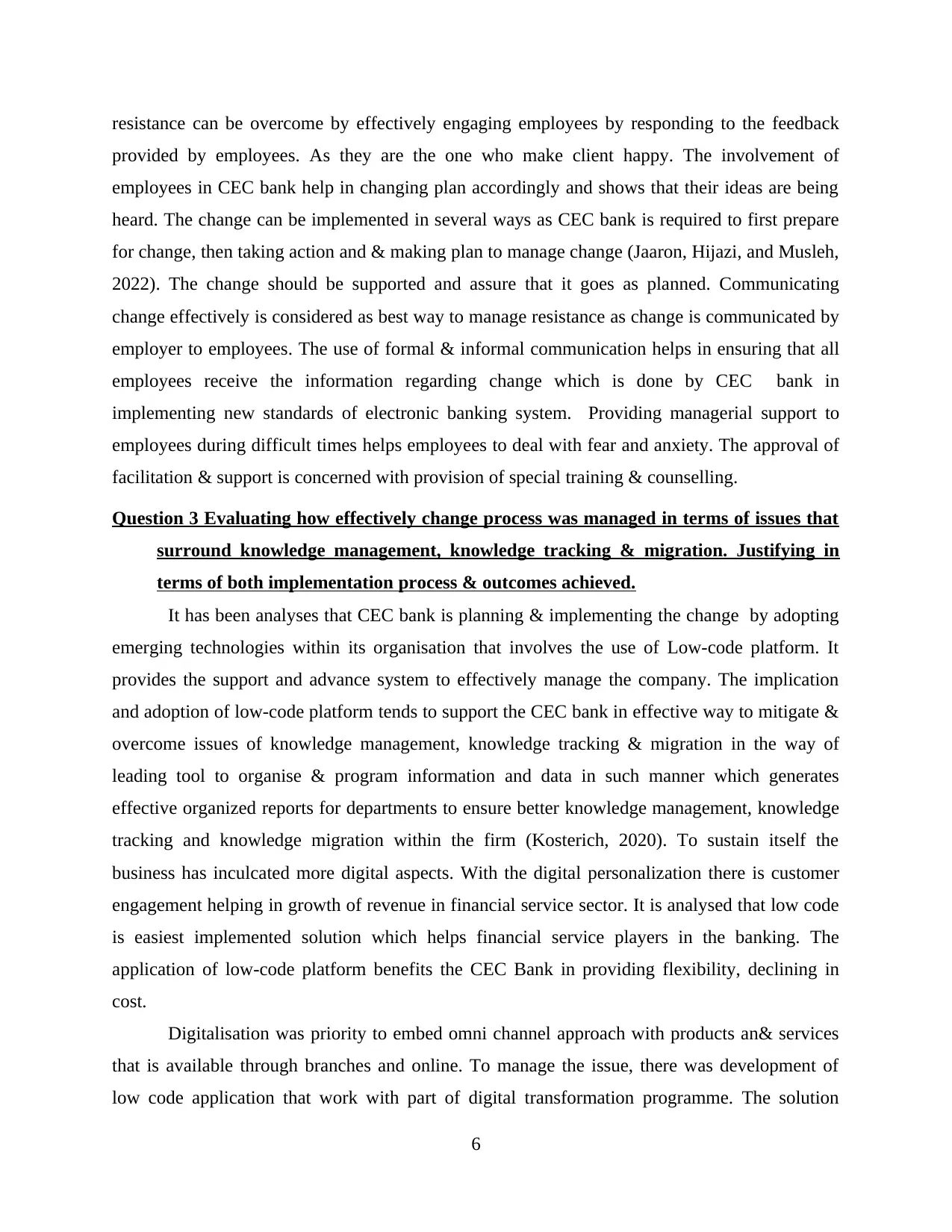
resistance can be overcome by effectively engaging employees by responding to the feedback
provided by employees. As they are the one who make client happy. The involvement of
employees in CEC bank help in changing plan accordingly and shows that their ideas are being
heard. The change can be implemented in several ways as CEC bank is required to first prepare
for change, then taking action and & making plan to manage change (Jaaron, Hijazi, and Musleh,
2022). The change should be supported and assure that it goes as planned. Communicating
change effectively is considered as best way to manage resistance as change is communicated by
employer to employees. The use of formal & informal communication helps in ensuring that all
employees receive the information regarding change which is done by CEC bank in
implementing new standards of electronic banking system. Providing managerial support to
employees during difficult times helps employees to deal with fear and anxiety. The approval of
facilitation & support is concerned with provision of special training & counselling.
Question 3 Evaluating how effectively change process was managed in terms of issues that
surround knowledge management, knowledge tracking & migration. Justifying in
terms of both implementation process & outcomes achieved.
It has been analyses that CEC bank is planning & implementing the change by adopting
emerging technologies within its organisation that involves the use of Low-code platform. It
provides the support and advance system to effectively manage the company. The implication
and adoption of low-code platform tends to support the CEC bank in effective way to mitigate &
overcome issues of knowledge management, knowledge tracking & migration in the way of
leading tool to organise & program information and data in such manner which generates
effective organized reports for departments to ensure better knowledge management, knowledge
tracking and knowledge migration within the firm (Kosterich, 2020). To sustain itself the
business has inculcated more digital aspects. With the digital personalization there is customer
engagement helping in growth of revenue in financial service sector. It is analysed that low code
is easiest implemented solution which helps financial service players in the banking. The
application of low-code platform benefits the CEC Bank in providing flexibility, declining in
cost.
Digitalisation was priority to embed omni channel approach with products an& services
that is available through branches and online. To manage the issue, there was development of
low code application that work with part of digital transformation programme. The solution
6
provided by employees. As they are the one who make client happy. The involvement of
employees in CEC bank help in changing plan accordingly and shows that their ideas are being
heard. The change can be implemented in several ways as CEC bank is required to first prepare
for change, then taking action and & making plan to manage change (Jaaron, Hijazi, and Musleh,
2022). The change should be supported and assure that it goes as planned. Communicating
change effectively is considered as best way to manage resistance as change is communicated by
employer to employees. The use of formal & informal communication helps in ensuring that all
employees receive the information regarding change which is done by CEC bank in
implementing new standards of electronic banking system. Providing managerial support to
employees during difficult times helps employees to deal with fear and anxiety. The approval of
facilitation & support is concerned with provision of special training & counselling.
Question 3 Evaluating how effectively change process was managed in terms of issues that
surround knowledge management, knowledge tracking & migration. Justifying in
terms of both implementation process & outcomes achieved.
It has been analyses that CEC bank is planning & implementing the change by adopting
emerging technologies within its organisation that involves the use of Low-code platform. It
provides the support and advance system to effectively manage the company. The implication
and adoption of low-code platform tends to support the CEC bank in effective way to mitigate &
overcome issues of knowledge management, knowledge tracking & migration in the way of
leading tool to organise & program information and data in such manner which generates
effective organized reports for departments to ensure better knowledge management, knowledge
tracking and knowledge migration within the firm (Kosterich, 2020). To sustain itself the
business has inculcated more digital aspects. With the digital personalization there is customer
engagement helping in growth of revenue in financial service sector. It is analysed that low code
is easiest implemented solution which helps financial service players in the banking. The
application of low-code platform benefits the CEC Bank in providing flexibility, declining in
cost.
Digitalisation was priority to embed omni channel approach with products an& services
that is available through branches and online. To manage the issue, there was development of
low code application that work with part of digital transformation programme. The solution
6
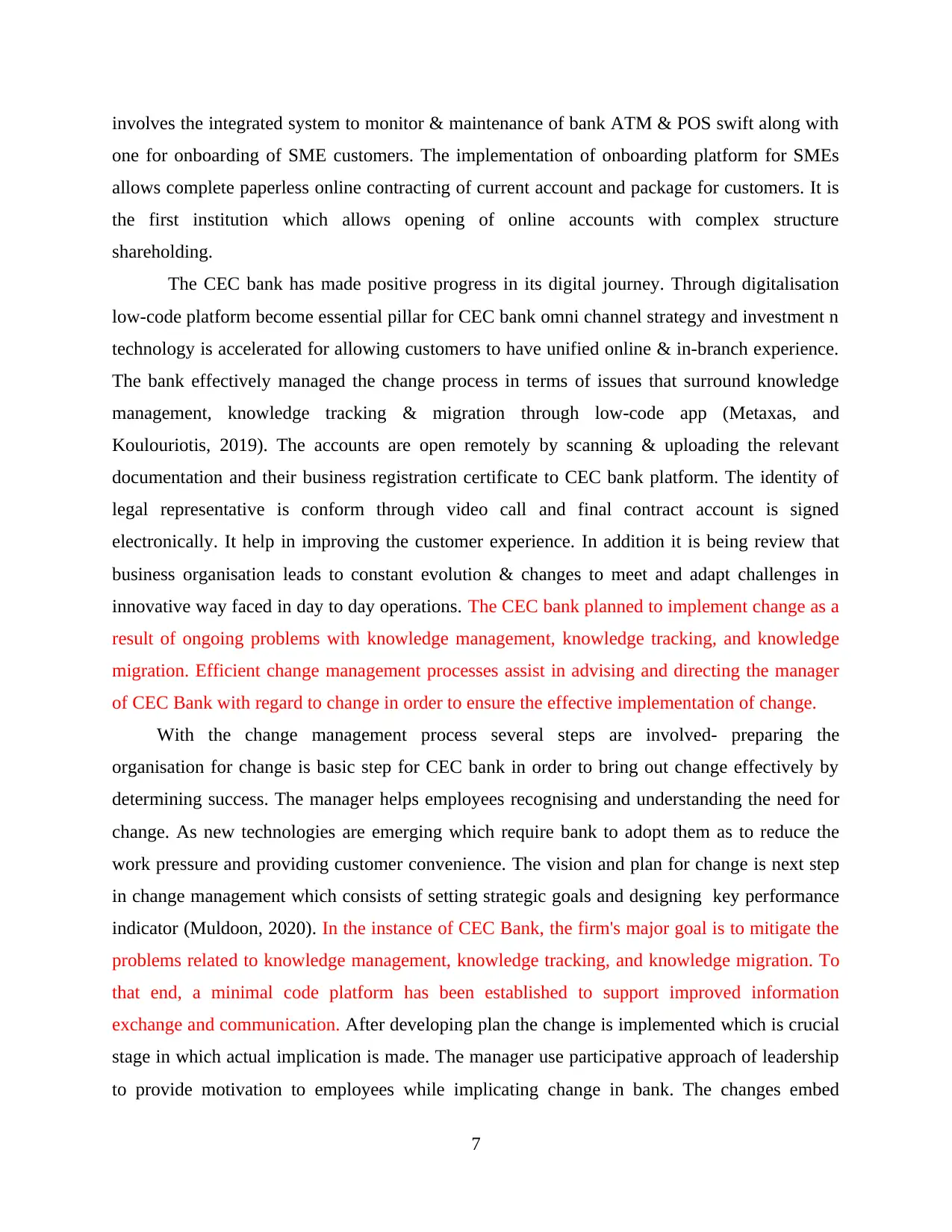
involves the integrated system to monitor & maintenance of bank ATM & POS swift along with
one for onboarding of SME customers. The implementation of onboarding platform for SMEs
allows complete paperless online contracting of current account and package for customers. It is
the first institution which allows opening of online accounts with complex structure
shareholding.
The CEC bank has made positive progress in its digital journey. Through digitalisation
low-code platform become essential pillar for CEC bank omni channel strategy and investment n
technology is accelerated for allowing customers to have unified online & in-branch experience.
The bank effectively managed the change process in terms of issues that surround knowledge
management, knowledge tracking & migration through low-code app (Metaxas, and
Koulouriotis, 2019). The accounts are open remotely by scanning & uploading the relevant
documentation and their business registration certificate to CEC bank platform. The identity of
legal representative is conform through video call and final contract account is signed
electronically. It help in improving the customer experience. In addition it is being review that
business organisation leads to constant evolution & changes to meet and adapt challenges in
innovative way faced in day to day operations. The CEC bank planned to implement change as a
result of ongoing problems with knowledge management, knowledge tracking, and knowledge
migration. Efficient change management processes assist in advising and directing the manager
of CEC Bank with regard to change in order to ensure the effective implementation of change.
With the change management process several steps are involved- preparing the
organisation for change is basic step for CEC bank in order to bring out change effectively by
determining success. The manager helps employees recognising and understanding the need for
change. As new technologies are emerging which require bank to adopt them as to reduce the
work pressure and providing customer convenience. The vision and plan for change is next step
in change management which consists of setting strategic goals and designing key performance
indicator (Muldoon, 2020). In the instance of CEC Bank, the firm's major goal is to mitigate the
problems related to knowledge management, knowledge tracking, and knowledge migration. To
that end, a minimal code platform has been established to support improved information
exchange and communication. After developing plan the change is implemented which is crucial
stage in which actual implication is made. The manager use participative approach of leadership
to provide motivation to employees while implicating change in bank. The changes embed
7
one for onboarding of SME customers. The implementation of onboarding platform for SMEs
allows complete paperless online contracting of current account and package for customers. It is
the first institution which allows opening of online accounts with complex structure
shareholding.
The CEC bank has made positive progress in its digital journey. Through digitalisation
low-code platform become essential pillar for CEC bank omni channel strategy and investment n
technology is accelerated for allowing customers to have unified online & in-branch experience.
The bank effectively managed the change process in terms of issues that surround knowledge
management, knowledge tracking & migration through low-code app (Metaxas, and
Koulouriotis, 2019). The accounts are open remotely by scanning & uploading the relevant
documentation and their business registration certificate to CEC bank platform. The identity of
legal representative is conform through video call and final contract account is signed
electronically. It help in improving the customer experience. In addition it is being review that
business organisation leads to constant evolution & changes to meet and adapt challenges in
innovative way faced in day to day operations. The CEC bank planned to implement change as a
result of ongoing problems with knowledge management, knowledge tracking, and knowledge
migration. Efficient change management processes assist in advising and directing the manager
of CEC Bank with regard to change in order to ensure the effective implementation of change.
With the change management process several steps are involved- preparing the
organisation for change is basic step for CEC bank in order to bring out change effectively by
determining success. The manager helps employees recognising and understanding the need for
change. As new technologies are emerging which require bank to adopt them as to reduce the
work pressure and providing customer convenience. The vision and plan for change is next step
in change management which consists of setting strategic goals and designing key performance
indicator (Muldoon, 2020). In the instance of CEC Bank, the firm's major goal is to mitigate the
problems related to knowledge management, knowledge tracking, and knowledge migration. To
that end, a minimal code platform has been established to support improved information
exchange and communication. After developing plan the change is implemented which is crucial
stage in which actual implication is made. The manager use participative approach of leadership
to provide motivation to employees while implicating change in bank. The changes embed
7
⊘ This is a preview!⊘
Do you want full access?
Subscribe today to unlock all pages.

Trusted by 1+ million students worldwide
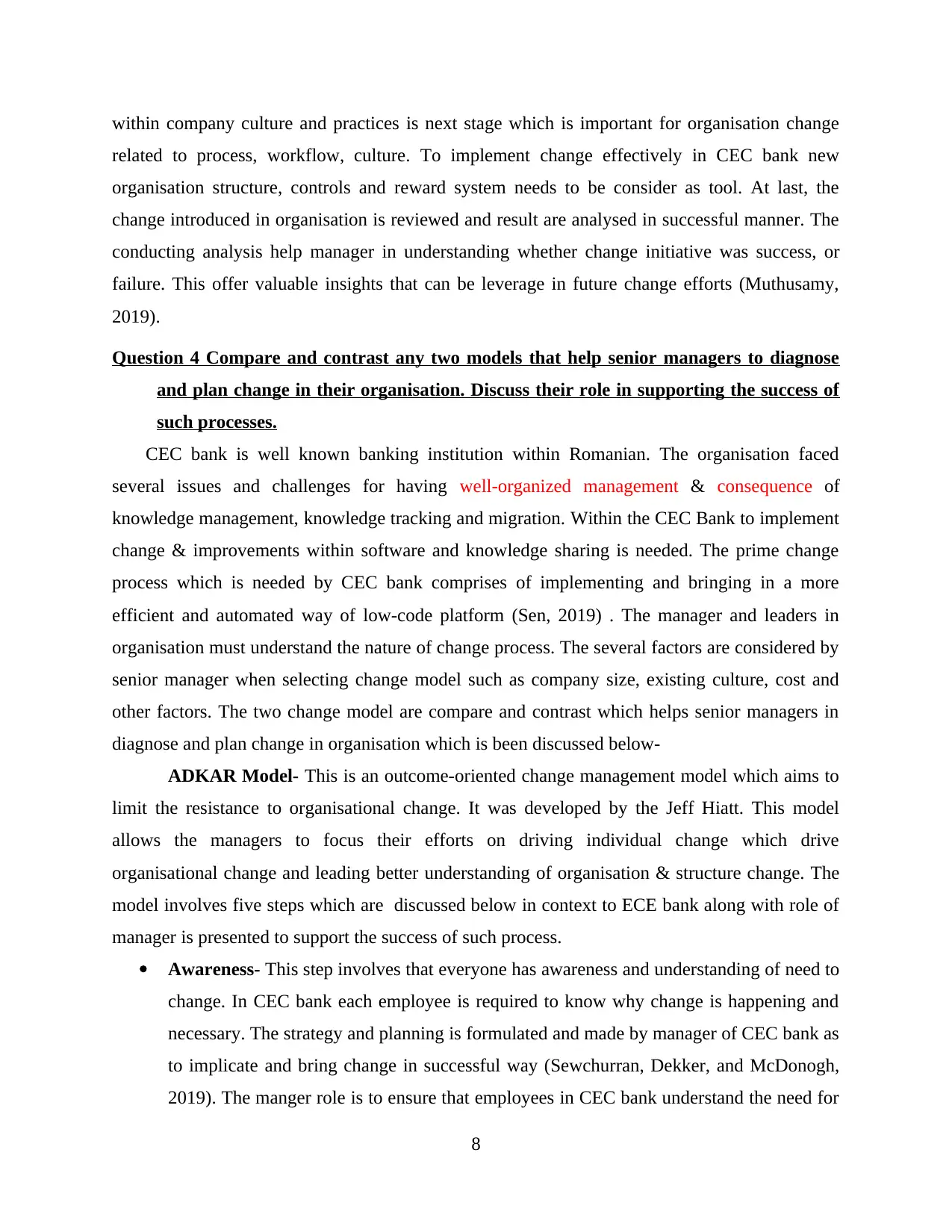
within company culture and practices is next stage which is important for organisation change
related to process, workflow, culture. To implement change effectively in CEC bank new
organisation structure, controls and reward system needs to be consider as tool. At last, the
change introduced in organisation is reviewed and result are analysed in successful manner. The
conducting analysis help manager in understanding whether change initiative was success, or
failure. This offer valuable insights that can be leverage in future change efforts (Muthusamy,
2019).
Question 4 Compare and contrast any two models that help senior managers to diagnose
and plan change in their organisation. Discuss their role in supporting the success of
such processes.
CEC bank is well known banking institution within Romanian. The organisation faced
several issues and challenges for having well-organized management & consequence of
knowledge management, knowledge tracking and migration. Within the CEC Bank to implement
change & improvements within software and knowledge sharing is needed. The prime change
process which is needed by CEC bank comprises of implementing and bringing in a more
efficient and automated way of low-code platform (Sen, 2019) . The manager and leaders in
organisation must understand the nature of change process. The several factors are considered by
senior manager when selecting change model such as company size, existing culture, cost and
other factors. The two change model are compare and contrast which helps senior managers in
diagnose and plan change in organisation which is been discussed below-
ADKAR Model- This is an outcome-oriented change management model which aims to
limit the resistance to organisational change. It was developed by the Jeff Hiatt. This model
allows the managers to focus their efforts on driving individual change which drive
organisational change and leading better understanding of organisation & structure change. The
model involves five steps which are discussed below in context to ECE bank along with role of
manager is presented to support the success of such process.
Awareness- This step involves that everyone has awareness and understanding of need to
change. In CEC bank each employee is required to know why change is happening and
necessary. The strategy and planning is formulated and made by manager of CEC bank as
to implicate and bring change in successful way (Sewchurran, Dekker, and McDonogh,
2019). The manger role is to ensure that employees in CEC bank understand the need for
8
related to process, workflow, culture. To implement change effectively in CEC bank new
organisation structure, controls and reward system needs to be consider as tool. At last, the
change introduced in organisation is reviewed and result are analysed in successful manner. The
conducting analysis help manager in understanding whether change initiative was success, or
failure. This offer valuable insights that can be leverage in future change efforts (Muthusamy,
2019).
Question 4 Compare and contrast any two models that help senior managers to diagnose
and plan change in their organisation. Discuss their role in supporting the success of
such processes.
CEC bank is well known banking institution within Romanian. The organisation faced
several issues and challenges for having well-organized management & consequence of
knowledge management, knowledge tracking and migration. Within the CEC Bank to implement
change & improvements within software and knowledge sharing is needed. The prime change
process which is needed by CEC bank comprises of implementing and bringing in a more
efficient and automated way of low-code platform (Sen, 2019) . The manager and leaders in
organisation must understand the nature of change process. The several factors are considered by
senior manager when selecting change model such as company size, existing culture, cost and
other factors. The two change model are compare and contrast which helps senior managers in
diagnose and plan change in organisation which is been discussed below-
ADKAR Model- This is an outcome-oriented change management model which aims to
limit the resistance to organisational change. It was developed by the Jeff Hiatt. This model
allows the managers to focus their efforts on driving individual change which drive
organisational change and leading better understanding of organisation & structure change. The
model involves five steps which are discussed below in context to ECE bank along with role of
manager is presented to support the success of such process.
Awareness- This step involves that everyone has awareness and understanding of need to
change. In CEC bank each employee is required to know why change is happening and
necessary. The strategy and planning is formulated and made by manager of CEC bank as
to implicate and bring change in successful way (Sewchurran, Dekker, and McDonogh,
2019). The manger role is to ensure that employees in CEC bank understand the need for
8
Paraphrase This Document
Need a fresh take? Get an instant paraphrase of this document with our AI Paraphraser
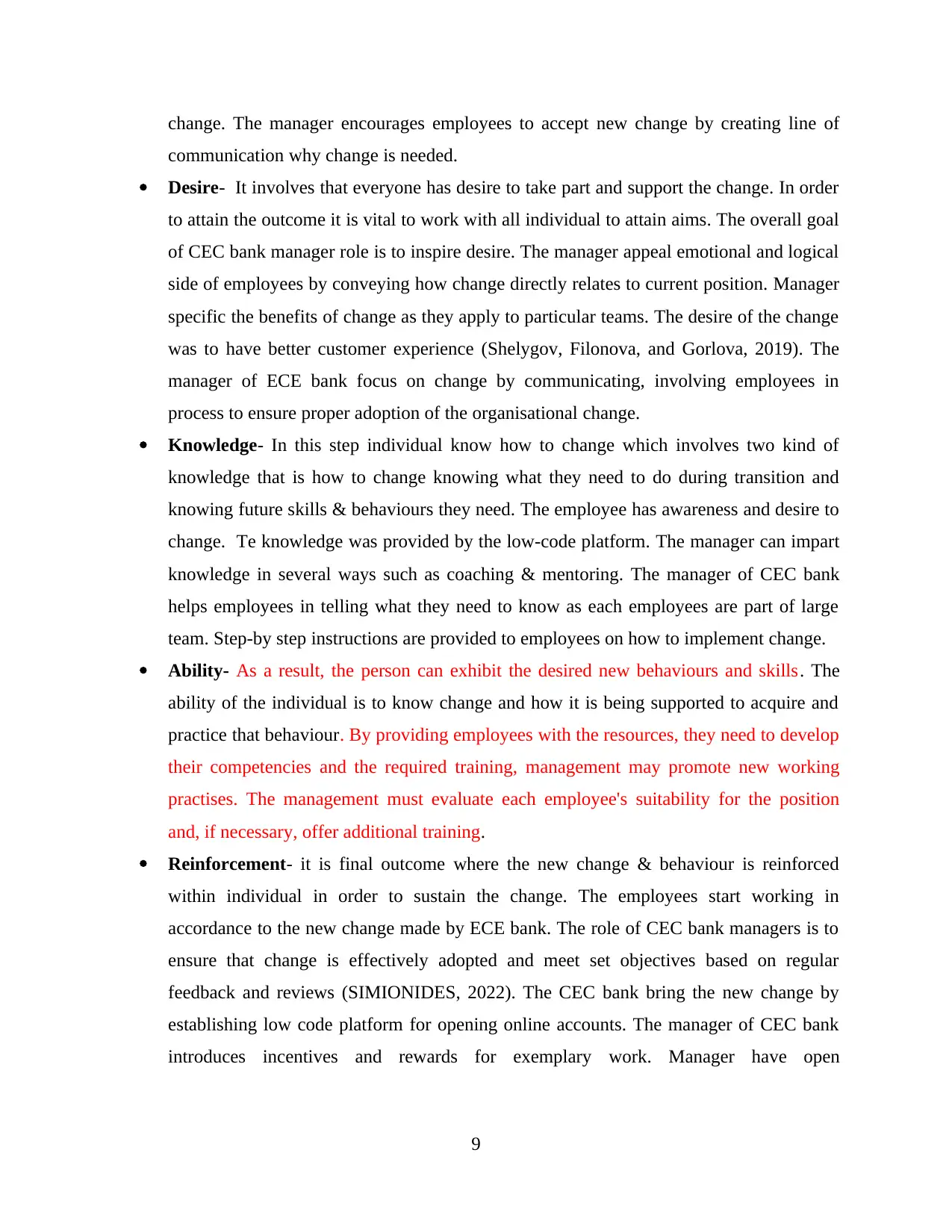
change. The manager encourages employees to accept new change by creating line of
communication why change is needed.
Desire- It involves that everyone has desire to take part and support the change. In order
to attain the outcome it is vital to work with all individual to attain aims. The overall goal
of CEC bank manager role is to inspire desire. The manager appeal emotional and logical
side of employees by conveying how change directly relates to current position. Manager
specific the benefits of change as they apply to particular teams. The desire of the change
was to have better customer experience (Shelygov, Filonova, and Gorlova, 2019). The
manager of ECE bank focus on change by communicating, involving employees in
process to ensure proper adoption of the organisational change.
Knowledge- In this step individual know how to change which involves two kind of
knowledge that is how to change knowing what they need to do during transition and
knowing future skills & behaviours they need. The employee has awareness and desire to
change. Te knowledge was provided by the low-code platform. The manager can impart
knowledge in several ways such as coaching & mentoring. The manager of CEC bank
helps employees in telling what they need to know as each employees are part of large
team. Step-by step instructions are provided to employees on how to implement change.
Ability- As a result, the person can exhibit the desired new behaviours and skills. The
ability of the individual is to know change and how it is being supported to acquire and
practice that behaviour. By providing employees with the resources, they need to develop
their competencies and the required training, management may promote new working
practises. The management must evaluate each employee's suitability for the position
and, if necessary, offer additional training.
Reinforcement- it is final outcome where the new change & behaviour is reinforced
within individual in order to sustain the change. The employees start working in
accordance to the new change made by ECE bank. The role of CEC bank managers is to
ensure that change is effectively adopted and meet set objectives based on regular
feedback and reviews (SIMIONIDES, 2022). The CEC bank bring the new change by
establishing low code platform for opening online accounts. The manager of CEC bank
introduces incentives and rewards for exemplary work. Manager have open
9
communication why change is needed.
Desire- It involves that everyone has desire to take part and support the change. In order
to attain the outcome it is vital to work with all individual to attain aims. The overall goal
of CEC bank manager role is to inspire desire. The manager appeal emotional and logical
side of employees by conveying how change directly relates to current position. Manager
specific the benefits of change as they apply to particular teams. The desire of the change
was to have better customer experience (Shelygov, Filonova, and Gorlova, 2019). The
manager of ECE bank focus on change by communicating, involving employees in
process to ensure proper adoption of the organisational change.
Knowledge- In this step individual know how to change which involves two kind of
knowledge that is how to change knowing what they need to do during transition and
knowing future skills & behaviours they need. The employee has awareness and desire to
change. Te knowledge was provided by the low-code platform. The manager can impart
knowledge in several ways such as coaching & mentoring. The manager of CEC bank
helps employees in telling what they need to know as each employees are part of large
team. Step-by step instructions are provided to employees on how to implement change.
Ability- As a result, the person can exhibit the desired new behaviours and skills. The
ability of the individual is to know change and how it is being supported to acquire and
practice that behaviour. By providing employees with the resources, they need to develop
their competencies and the required training, management may promote new working
practises. The management must evaluate each employee's suitability for the position
and, if necessary, offer additional training.
Reinforcement- it is final outcome where the new change & behaviour is reinforced
within individual in order to sustain the change. The employees start working in
accordance to the new change made by ECE bank. The role of CEC bank managers is to
ensure that change is effectively adopted and meet set objectives based on regular
feedback and reviews (SIMIONIDES, 2022). The CEC bank bring the new change by
establishing low code platform for opening online accounts. The manager of CEC bank
introduces incentives and rewards for exemplary work. Manager have open
9
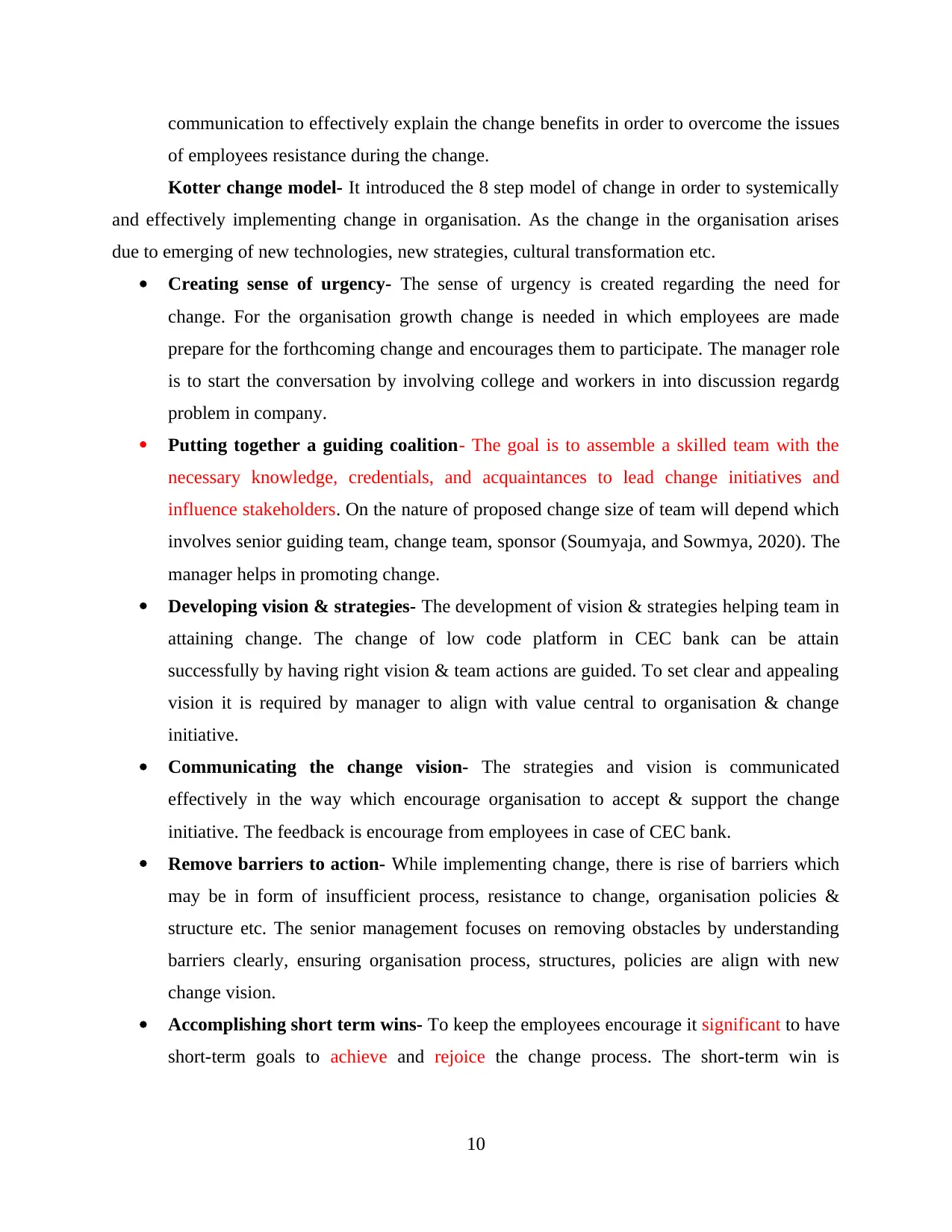
communication to effectively explain the change benefits in order to overcome the issues
of employees resistance during the change.
Kotter change model- It introduced the 8 step model of change in order to systemically
and effectively implementing change in organisation. As the change in the organisation arises
due to emerging of new technologies, new strategies, cultural transformation etc.
Creating sense of urgency- The sense of urgency is created regarding the need for
change. For the organisation growth change is needed in which employees are made
prepare for the forthcoming change and encourages them to participate. The manager role
is to start the conversation by involving college and workers in into discussion regardg
problem in company.
Putting together a guiding coalition- The goal is to assemble a skilled team with the
necessary knowledge, credentials, and acquaintances to lead change initiatives and
influence stakeholders. On the nature of proposed change size of team will depend which
involves senior guiding team, change team, sponsor (Soumyaja, and Sowmya, 2020). The
manager helps in promoting change.
Developing vision & strategies- The development of vision & strategies helping team in
attaining change. The change of low code platform in CEC bank can be attain
successfully by having right vision & team actions are guided. To set clear and appealing
vision it is required by manager to align with value central to organisation & change
initiative.
Communicating the change vision- The strategies and vision is communicated
effectively in the way which encourage organisation to accept & support the change
initiative. The feedback is encourage from employees in case of CEC bank.
Remove barriers to action- While implementing change, there is rise of barriers which
may be in form of insufficient process, resistance to change, organisation policies &
structure etc. The senior management focuses on removing obstacles by understanding
barriers clearly, ensuring organisation process, structures, policies are align with new
change vision.
Accomplishing short term wins- To keep the employees encourage it significant to have
short-term goals to achieve and rejoice the change process. The short-term win is
10
of employees resistance during the change.
Kotter change model- It introduced the 8 step model of change in order to systemically
and effectively implementing change in organisation. As the change in the organisation arises
due to emerging of new technologies, new strategies, cultural transformation etc.
Creating sense of urgency- The sense of urgency is created regarding the need for
change. For the organisation growth change is needed in which employees are made
prepare for the forthcoming change and encourages them to participate. The manager role
is to start the conversation by involving college and workers in into discussion regardg
problem in company.
Putting together a guiding coalition- The goal is to assemble a skilled team with the
necessary knowledge, credentials, and acquaintances to lead change initiatives and
influence stakeholders. On the nature of proposed change size of team will depend which
involves senior guiding team, change team, sponsor (Soumyaja, and Sowmya, 2020). The
manager helps in promoting change.
Developing vision & strategies- The development of vision & strategies helping team in
attaining change. The change of low code platform in CEC bank can be attain
successfully by having right vision & team actions are guided. To set clear and appealing
vision it is required by manager to align with value central to organisation & change
initiative.
Communicating the change vision- The strategies and vision is communicated
effectively in the way which encourage organisation to accept & support the change
initiative. The feedback is encourage from employees in case of CEC bank.
Remove barriers to action- While implementing change, there is rise of barriers which
may be in form of insufficient process, resistance to change, organisation policies &
structure etc. The senior management focuses on removing obstacles by understanding
barriers clearly, ensuring organisation process, structures, policies are align with new
change vision.
Accomplishing short term wins- To keep the employees encourage it significant to have
short-term goals to achieve and rejoice the change process. The short-term win is
10
⊘ This is a preview!⊘
Do you want full access?
Subscribe today to unlock all pages.

Trusted by 1+ million students worldwide
1 out of 15
Related Documents
Your All-in-One AI-Powered Toolkit for Academic Success.
+13062052269
info@desklib.com
Available 24*7 on WhatsApp / Email
![[object Object]](/_next/static/media/star-bottom.7253800d.svg)
Unlock your academic potential
Copyright © 2020–2025 A2Z Services. All Rights Reserved. Developed and managed by ZUCOL.




